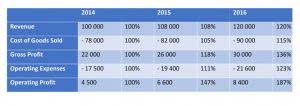
This can be difficult if the entities have different reporting practices or if specific data points move between books over time. Consolidation is an important concept in business to improve accounting and other processes. Businesses often use consolidation when merging with or acquiring another company, as this allows them to combine the financial information of both entities into a single data set. It makes it easier for businesses to analyze their overall financial performance and make informed decisions to guide their future growth. An example of intercompany consolidation is when a parent company owns several subsidiaries.
Additionally, it allows for faster access to valuable insights about performance trends across all subsidiaries, which can help with decision-making processes. The term has since become a mainstay of the accounting world, with organizations worldwide using it to understand their finances and make more informed decisions. Consolidation is a widely used accounting term, but other words related to consolidation are essential for accountants and business owners to know. Verify that the contents of all asset, liability, and equity accounts for both the subsidiaries and the corporate parent are correct, and adjust as necessary. Company A reported $2 million higher net income under IFRS than GAAP in 20X1 mainly due to IFRS treatment of noncontrolling interests as equity rather than a separate item. Within the consumer market, consolidation includes using a single loan to pay off all of the debts that are part of the consolidation.
Example 3. How is the word “consolidation” used in the field of accounting?
In May 2011 the Board issued IFRS 10 Consolidated Financial Statements to supersede IAS 27. IFRS 12 Disclosure of Interests in Other Entities, also issued in May 2011, replaced the disclosure requirements in IAS 27. IFRS 10 incorporates the guidance contained in two related Interpretations (SIC‑12 Consolidation‑Special Purpose Entities and SIC‑33 Consolidation). In 2016 , the FASB added a project to its agenda to reorganize the guidance in ASC 810 into a new Codification topic, ASC 812.
- Goodwill represents intangible assets like brand recognition, customer relationships, intellectual property, and other factors that contribute to future earnings potential.
- The parent company’s balance sheet lists all of the business’s assets and income or costs.
- The consolidation method requires that all assets and liabilities be combined so that what comes out is one unified set of financials.
- On a consolidated balance sheet, the parent company reports 100% of each subsidiary’s assets and liabilities, along with the noncontrolling interest and goodwill resulting from the acquisition.
- The consolidated financial statements will include both the parent and subsidiary’s financial information within them, usually using only the parent entity name on the face of that statement.
If a subsidiary uses a different currency as its operating currency, an additional consolidation accounting step is to convert its financial statements into the operating currency of the parent company. This will likely include distributions to investors, creditors, and lenders, and perhaps to any government entities involved in the oversight of the business. The cost method is used when the parent company holds less than 20% ownership in the subsidiary. The parent company recognizes dividend income from the subsidiary on the income statement but does not record a proportional share of the subsidiary’s earnings.
The most significant differences between the voting interest entity model and the VIE model are summarized below:
It begins by taking an entity’s total assets and subtracting its total liabilities to get its stockholders’ equity, also known as net worth or shareholder value. Proportionate consolidation is a type of consolidation accounting used to report companies’ financial activities in which two or more parties have an ownership interest. Consolidation can be helpful for businesses with different subsidiaries or divisions as it allows them to understand their overall performance and financial position better.
In this case, the more prominent company adds the smaller business’s assets and liabilities to its financial statements. Reduced risk happens by offsetting potential losses from one company with potential gains from another within the same consolidated entity. By consolidating multiple companies into consolidated meaning in accounting one entity, investors can ensure their investments are secure. Positive performance in other areas within the consolidated group may neutralize any negative impact on one company. Consolidation is essential for businesses to improve their overall visibility and understanding of their finances.

